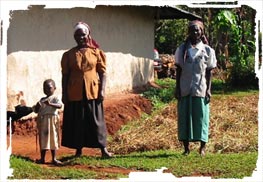El Batán, Mexico
August 31, 2005
Bidding to Balance Color with
Quality

CIMMYT economist Simon Kimenju hands a bag of maize meal
to a winning farmer in exchange
for the money. |
Kenyan farmers bid
for color or quality in experimental auctions to determine how
well maize with enriched vitamin A will catch on. Traditionally,
East Africans prefer white maize, but vitamin A maize, being
developed by CIMMYT and HarvestPlus, the CGIAR Biofortification
Challenge Program, will be yellow because of the increased
beta-carotene content. Will the nutritional value of the yellow
maize overcome East Africans’ color bias?
CIMMYT researchers
tried to answer this question in a series of novel experimental
auctions held in Vihiga and Siaya, western Kenya. By giving
consumers real money to bid for real maize meal, they hoped to
properly estimate a customer’s willingness to pay for vitamin
A-enriched maize. The highest bidders won the auction and
exchanged their bag of maize for their choice of white, yellow,
or white vitamin-enriched maize, after paying the money. By
creating an active market, researchers found a way to determine
how much demand there would be for maize with perhaps an
unpopular color but superior quality.
The HarvestPlus
Challenge Program, an international consortium of collaborative
partners that includes CIMMYT, aims to produce new crop
varieties to reduce micronutrient malnutrition, also known as
“hidden hunger.” They are working to develop maize that will
have higher levels of vitamin A available to those who eat it.
Vitamin A deficiencies plague over 50 million people in
sub-Saharan Africa and Latin America. According to HarvestPlus,
this deficiency damages the eye and severely weakens the immune
system.

Farmers like these women in Ematsuli village,
Vihiga, grow mostly white maize. |
Determining how
consumers will balance their desire for nutritionally superior
maize while sacrificing the color to which they are accustomed
sheds light on whether or not biofortified maize will be readily
adopted. “Despite a need for this knowledge, very few consumer
studies of the rural poor in sub-Saharan Africa have been done,”
says Hugo De Groote, CIMMYT economist.
“The results from
the maize auctions agree with our previous consumer surveys of
city dwellers,” says fellow scientist Simon Kimenju, “The
auction was very realistic—these prices are similar to those
found in Kenyan markets and grocery stores.” Although the
auction was found to be the most realistic compared to other
methods, it was also more expensive and took more preparation
and training time.
In addition to
discovering an accurate way to gauge consumer preferences,
researchers found another upside of the auctions: “The
one-on-one interactive nature of the auctions, using real
products, and real money makes it great fun for the
participants!” exclaims De Groote.
A full paper on
this topic was presented at the African Econometric Society
Conference, Nairobi, Kenya, 6–8 July 2005. It is available in
PDF form here (270 kb).
For further information,
contact Simon Kimenju (s.kimenju@cgiar.org)
or Hugo De Groote (h.degroote@cgiar.org). |